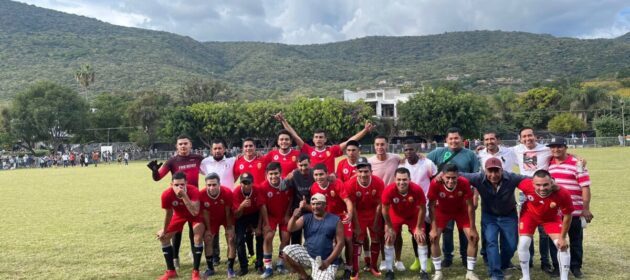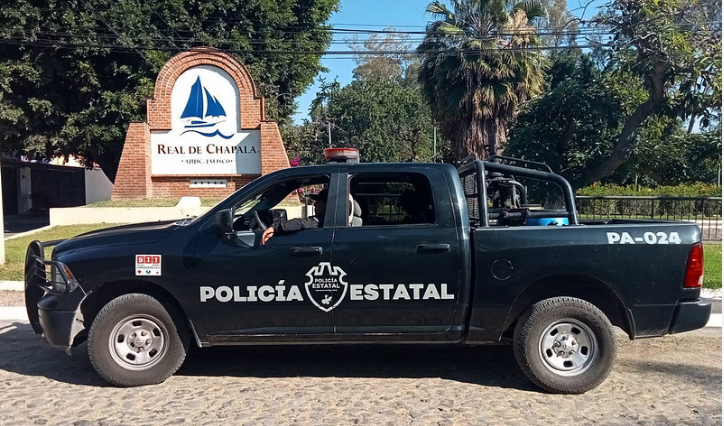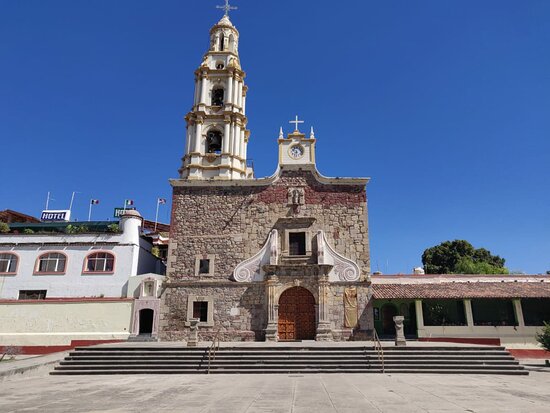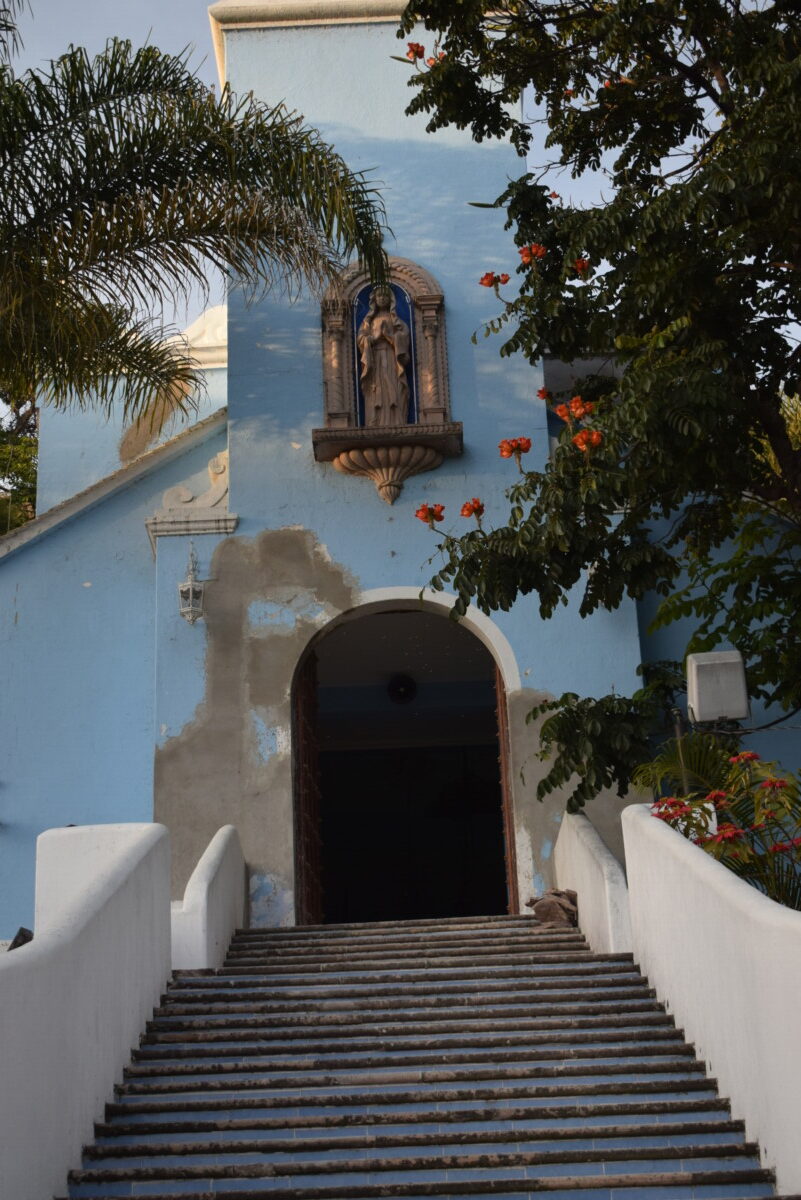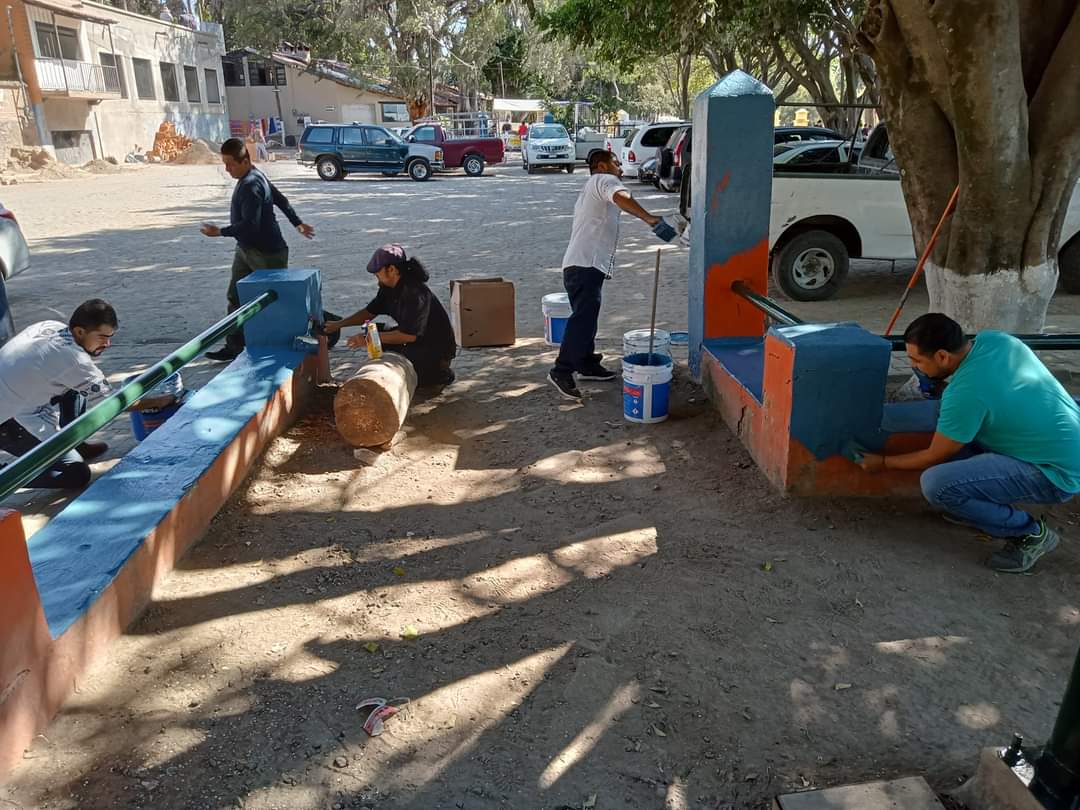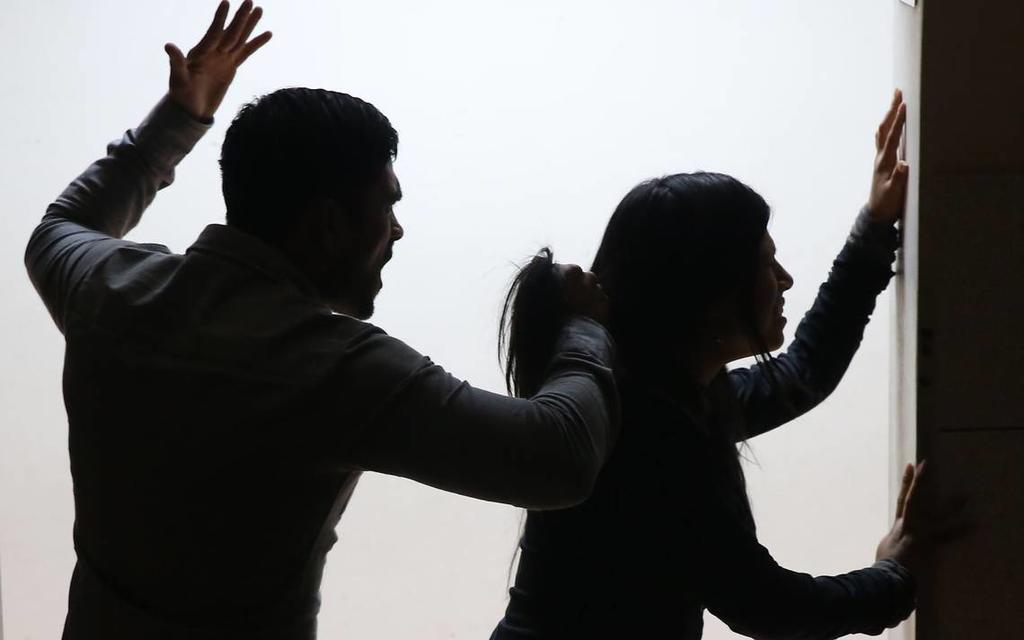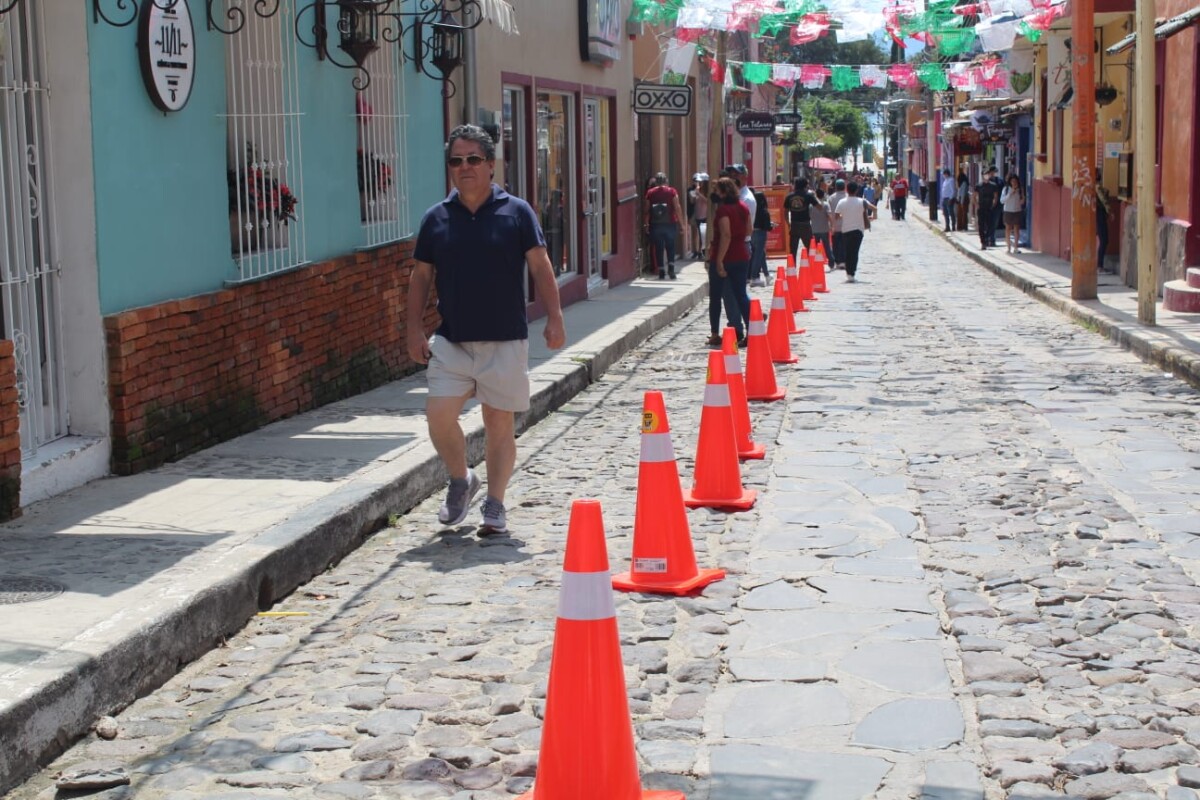ribera
Ribera Chronicles
The champion San Cristóbal team. Photo: Courtesy of Sergio Andrés Acosta.
María del Refugio Reynozo Medina — “San Cristóbal is a loving town,” says Giovanni López, the Colombian soccer player who participated in the last game of the 2021 season at La Ribera.
October 31 was just the final episode in a series of encounters between players, sponsors and fans. The 2020-2021 season, which began more than six months ago, involved encounters between the main towns of La Ribera (El Chante, El Tepehuaje, San Juan Cosalá, Jocotepec).
The grand finale was scheduled for October 31. The only ones to arrive were the Escombro team from El Chante and the San Cristóbal team from the town of San Cristóbal Zapotitlán. During the match, fans shouted “San Cris, San Cris!”until they were hoarse. They focused on the ball as they gulped from their cans of beer. Referees’ whistles resounded in the green field and the players’ bodies moved lightly under the midday sun.
At the end of a season with months of effort, the reds of “San Cris” had defeated Chapulines and Pumas from Jocotepec. They also defeated El Nacional, El Nuevo Nacional and El Júpiter, all from Nextipac.
With the shout of ¡goooool! and the noise of the fans, the San Cristóbal team was crowned champion and received the shiny cup in the middle of the field. They also received a prize of 12,000 pesos.

Wearing the red and white uniform of the San Cristóbal team. From left to right: Cristian Domínguez, Sergio Acosta, Neisser Valverde, Giovanni López and Osmar Steven. Photo: Courtesy of Sergio Andrés Acosta
After leaving the El Chante field, they returned to San Cristobal to participate in the celebration.
The arrival of the vehicles with the fans was accompanied by the sound of honking horns and shouts of joy along the main streets. Families gathered on street corners or outside their homes to watch the contingent pass by, heading first to the cemetery.
“We dedicate this victory to Luis Gómez “El Padrecito,” said one of the organizers with emotion. Luis passed away in November of last year and was a great promoter, director and soccer fan. The tribute was also for José Luis de la Luz, and his son of the same name. Both lost their lives in an accident and were important and beloved members of the soccer community.
At twilight, the caravan arrived at the cemetery led by a band playing “Un puño de tierra.”
Because it was the eve of Day of the Dead, many of the graves were freshly decorated with flowers and papel picado bows. Team members let the trophy rest for a few minutes on the grave of Luis Gómez, and the crowd sang with fervor as the grave turned into an altar. They said goodbye with “El muchacho alegre” and advanced to the tomb of the Luises, whom the fans remember as “El Catrín” and “El ruso,” to whom they dedicated another song.
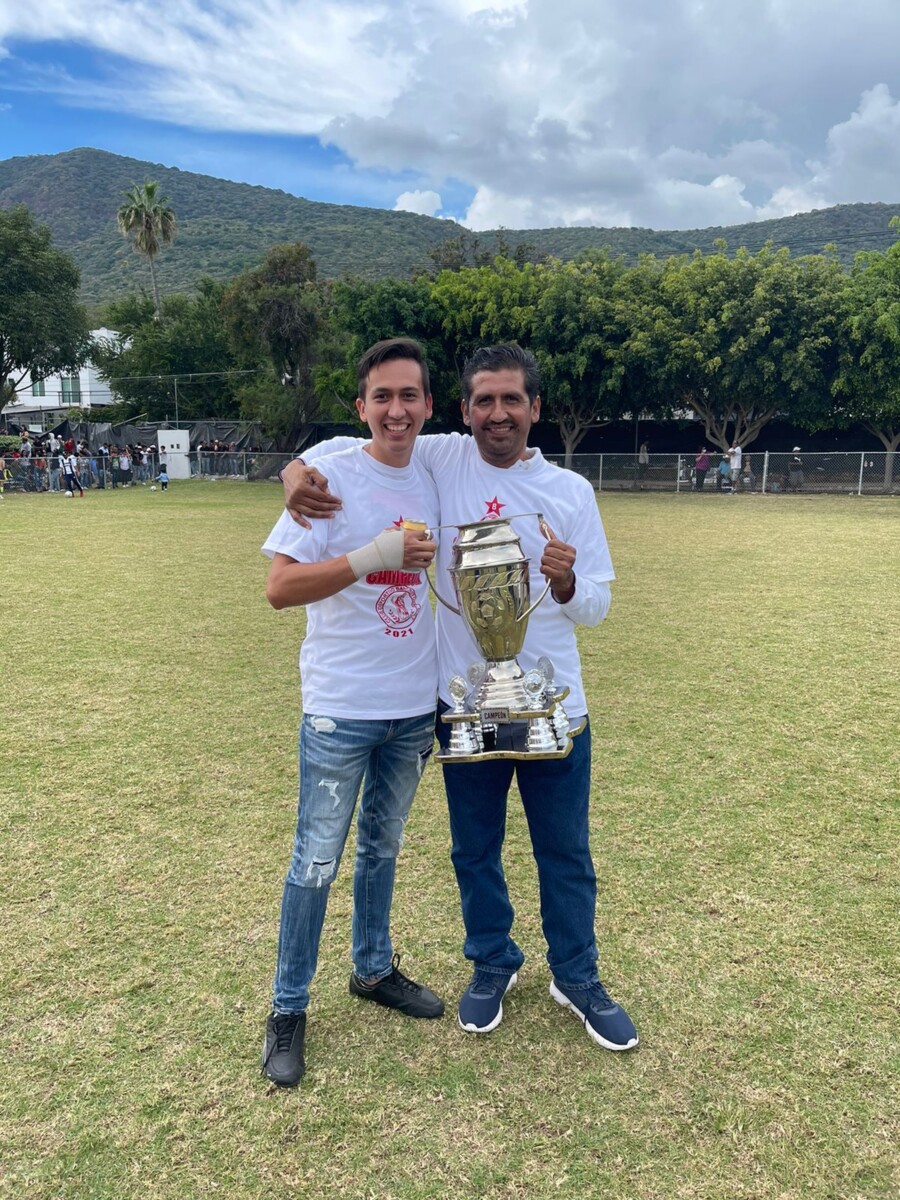
Germán Balmori with Germán Balmori Jr. One of the main promoters of the San Cristobal team. Photo: Courtesy of Diego Reynoso Aldrete.
The celebration lasted until late into the night in the lounge on the shore of the lake, where there was dinner and more music. The host was Germán Balmori, who has also been a team collaborator for many years. Elías García called the players to the stage to cheer them: Diego Reynoso, who played as right back; Osmar Steven, Colombian goalkeeper; Alonso Chavarría Bautista; Ángel Valdez; Colombians Cristian Domínguez, Neiser Valverde, Sergio Andrés Acosta and Giovanni López; Jorge Navarro El mosquita; Abraham Ibarra; and Oscar Cabañas.
The attendees immortalized the triumph with red and white t-shirts, some of which bore the names of the honorees; Russian, catrin with the image of the patron saint Señor San Cristobal.
“I wanted to give the victory to my team,” said Technical Director Isaías García Godoy. The final score of the championship game was 4-2, giving the team a season record of 6-3. With this, “El Sancris,” in the words of a fan, became not only champion, but also our champion.
Translated by Mike Rogers
Se arrestan a 19 personas por delitos contra la salud y robo en Chapala
Foto: Patrulla de la SSE. Foto: cortesía.
Redacción (Chapala, Jal).- Diez y nueve personas fueron arrestadas entre el 1 de octubre y el 22 de noviembre de este año, por delitos contra la salud y robo en Chapala.
Las acciones permitieron el arresto de 18 personas en presunta posesión de drogas y un detenido con un vehículo robado. Asimismo, dos personas fueron arrestadas por incurrir en faltas administrativas.
En dicho periodo, fueron recuperados 12 vehículos y una motocicleta con reporte de robo, así como una motocicleta que fue abandonada con droga.
La SSE tuvo un acercamiento con vecinos de Chapala para escuchar sus demandas en cuanto al mejoramiento de la seguridad en la ribera, por lo cual se puso en marcha una estrategia para cumplir con este objetivo.
Además, para evitar la delincuencia situacional, el personal de la Dirección de Prevención del Delito de la SSE realizó una proximidad con los ciudadanos de este municipio, difundiendo las medidas preventivas en cuanto al robo a persona, robo a negocio y robo a casa habitación, entre otros delitos.
Ajijic’s agricultural guild in danger of disappearing
St. Andrew Catholic Church.
Sofía Medeles (Ajijic, Jal.)- With no fields to sow and no cows to herd in Ajijic, the farmers’ guild, once one of the strongest of the nine guilds, is now one of the hardest hit in the Ajijic’s patron saint festivities.
The festivities in honor of San Andrés Apóstol are held from November 22 to 30 In the Parish of San Andrés Apóstol, where the patron saint of Ajijic is located.
Semanario Laguna spoke with one of the members (of the guild. Ramona Díaz, received the media outside her house hiding her hands to protect herself from the cold, nostalgically commented that her membership in the guild is because she inherited it from her father, who inherited it from her grandfather. Senora Diaz acknowledged that the guild is one of those that has been fading the most with time.
«It used to be a robust day because there was a lot of farming and ranching, but the guild members have been doing less and less. Today there are fewer than 25 of us who cooperate, and there is no longer anywhere to plant or have livestock, that is why the festivities have been lost,» she mentioned while raising her voice a little to be able to stand out among the noise of trucks and cars passing by outside her home.
She went on to say that the only thing left is the name, because only memories of this trade remain, and they will probably be those of this last generation. «I don’t think I will pass it on to my children, because they are no longer committed to the faith or to the profession. Not only my children, many young people no longer approach religion today.»
She said that another important factor in the lack of participation not only in her guild, but in all the guilds,is the diminished the day of the youth which is a colorful day with a lot of celebration in other areas, but here it is different, because they have been leaving aside religion and customs, they only see the celebration.»
Looking to the side, she recalls a tradition that is basically lost, in which the guild on the following day, made a small procession with lanterns to get to the last mass of the day which represented that they were receiving their day. They called this the «entrada.» «It would be nice if those of us who participate in the guilds could agree to wear a shawl and wear our tresses, so we could show more of our traditions and roots.»
Finally, she called on the community of Ajijic, adults, youth and children, to get more involved in the traditions that remain since, with pride, she says it is part of what makes Ajijic magical. «Another one I remember, is the battle of the roses -men giving roses to women during the dances in the plaza. It was nice and fun. It should be done again and we could motivate them, for example, by giving a prize to the one with the most roses. Let’s not let the traditions that made us what we are die.»
Translated by Sydney Metrick.
Chavo Luna: more than a musician, a teacher of young musicians
Chavo Luna in front of his house, «The future of music is uncertain, from being dead during the pandemic now the movement is reborn».
Jazmín Stengel – Salvador de Luna Castellanos, better known as Chavo Luna, began his career at the age of eight in 1956. His interest began the day he followed the musicians he saw pass by the main avenue of his town, Chapala, dressed in suits with instruments in hand.
The pursuit of that day led the boy to the Academy of the parish of San Francisco de Asís where the community band, «Niños Héroes,» founded by the priest Raúl Navarro was rehearsing. «That’s where I began to study,» said Chavo.
Chavo found a harmony that would accompany him throughout his life. Being mostly self-taught, he sought to learn from friends and colleagues who studied at the Conservatory, such as Humberto Rivera who accompanied him for two years, helping him to complement his musical training.
The quality of his music and the few opportunities to practice his profession in Chapala during his youth, led him in the 70’s to make the leap directly to the tapatías groups. The Youth Orchestra of Guadalajara was the first to open its doors to him. After that, Chavo was part of the orchestras directed by Nano González and Enrique Reyes, both famous musicians from Jalisco.
Luna told us about one of the best moments he experienced on stage. «The first day you play a solo well the people look at you and you can hear the applause,» he said with a hidden smile and eyes lit up with nostalgia as if he were reliving that moment from the warmth of his living room.
After that day his career took off. He was a member of the Arturo Xavier Gonzalez Santana Orchestra when it split in 1981, «the best ones formed their own group and those of us who were not so good stayed,» Chavo recalled.
Shortly thereafter, the Jalisco State Symphony Orchestra called him to its elite ensemble of musicians in the city where he remained for three years. «At first I hesitated, but I wanted to fit in with the greats and I realized I had the quality,» he said with a blush.
After a fifteen-year absence, «One day my sister told me that her three children wanted to learn music. I proposed to invite seven more of their friends to form a band.» Since 1983, Luna has gathered young people in the main square of the Chapala every Sunday to form the new band of Chapala.
At that time, the now 73-year-old maestro made a crucial life decision. “Since we musicians sacrifice time and effort, I dedicated mine to develop music among the young people of the town,» said Chavo not regretting leaving the big leagues to continue his legacy with music classes for clarinet, saxophone, trumpet, trombone and all the wind instruments he masters.
The effort over 28 years has never been in vain, and even if the pay is a simple plate of pozole with a couple of tostadas, the students have always made their work worthwhile. There are 18 students who have made it to the «mero arriba,» seven are now professionals and play with celebrities such as Alejandro «El Potrillo» Fernández, La Banda San Miguel, Banda Caramelo or La Pequeño Musical.
Chavo Luna may not have achieved worldwide fame like other musicians who pursued a public image, but the persistence and dedication he has shown throughout his 52-year career, his dedication to non-profit teaching, lead him to be recognized by his people with an outdoor tribute in the main square of the Chapala capital on November 21 at 8:00 p.m., where the Chavo Luna Wind Band, directed by Chavo Luna himself, will also perform.
Musicians in Chapala are scattered, but not absent. After a year of pandemic without festivities or music, the guild of mariacheros will meet again on Monday, November 22 at the Parish of San Francisco de Asís at 7:30 a.m. to celebrate a mass in honor of Santa Cecilia, Patron Saint of all musicians.
At the end of the mass, the groups will go to the little chapel of Santa Cecilia, on Chapala’s malecon in front of La Rampa restaurant, where the mariachis gather to sing the mañanitas to the patron saint, as they do every year.
The musicians from San Antonio Tlayacapan will organize a symbolic festival to celebrate their day, bringing together bands such as Astro Norteño, La Banda Caramelo, Banda Colegiala, Mórbida, La GS Band and Polo con su guitarra, combining musical genres for all tastes.
Also, in the parish of San Antonio de Padua, a mass in honor of St. Cecilia will be held at 7:00 a.m. and at the end, the mañanitas will be in the atrium of the same parish.
Translated by Sydney Metrick.
Mariana Macías arrived in Thailand to represent México in beauty contest
Mariana Macías, originally from San Antonio Tlayacapan.
Laguna staff. Mariana Macias, originally from San Antonio Tlayacapan, set foot on Thai soil to begin her quest for Miss Grand International. On Sunday night the winner of the «Miss Grand Mexico 2021» beauty pageant landed at Phuket International Airport to represent Mexico in the ninth edition of Miss Grand International 2021, on December 4.
The Lourdes Chapel will open its doors to the public after three years of being closed
The neighbors of the Lourdes neighborhood will see the doors of their chapel open to the public for the celebration of the Virgin of Guadalupe. Photo Jazmín Stengel.
Jazmín Stengel – After being closed to the public for more than three years and after six months of restoration work, the Chapel of Lourdes will finally open its doors to the public to commemorate the day of the Virgin of Guadalupe on December 12, as was done in 1940.
To date, more than 500,000 pesos (almost $24,000 USD) have been invested in the restoration work, according to the civil engineer, Enrique Petersen. These resources come from what the neighbors have been able to raise through donations, most of the time in material.
«Unlike earlier, they now prefer anonymous donations», commented Alejandra Martinez, daughter of Tere and Jose (Pepe) Martinez, neighbors of the community and treasurers of this collection. She added that many Chapalenses and foreigners have contributed their share, including Enrique Petersen who undertook the job of directing the work without charging a peso.
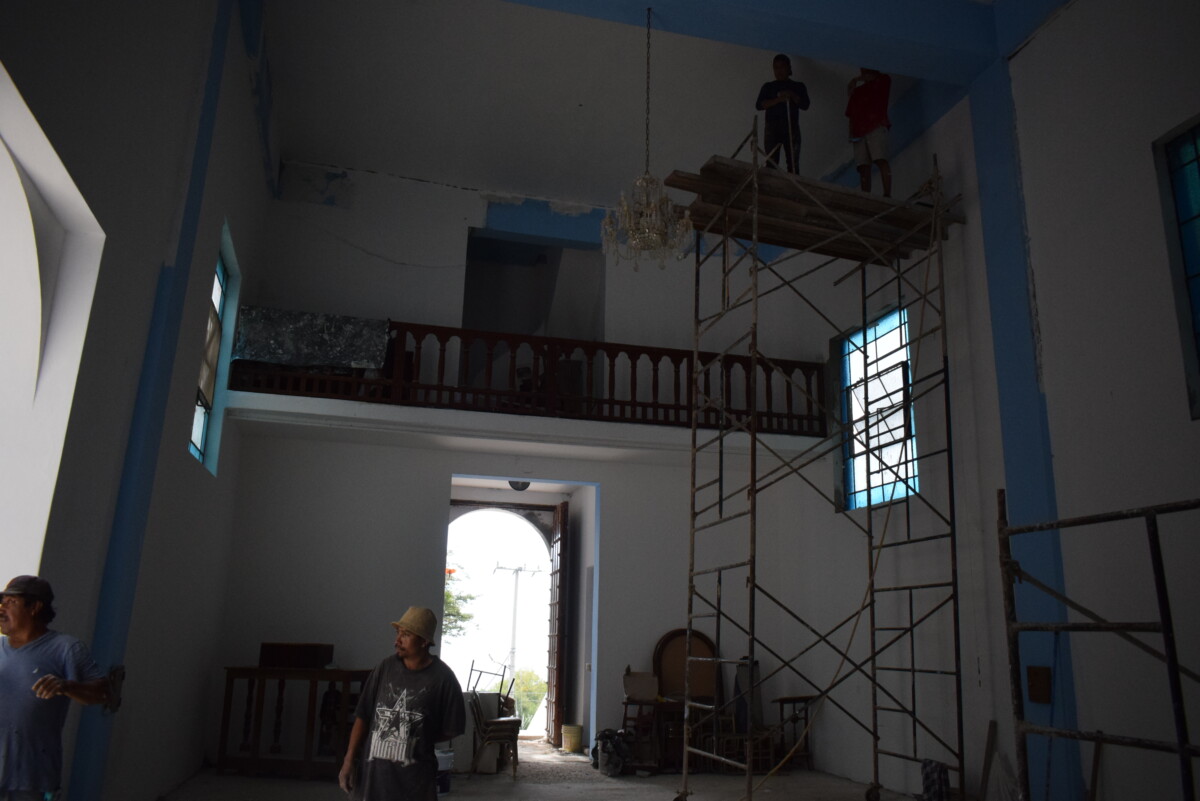
After six months of restoration work, there are still pending details of painting and finishing in the temple. Photo Jazmín Stengel.
The task has not been easy, since the labor expenses and some materials not donated tallied up to 70 thousand pesos one month, with even more expenses. The average monthly expenses remained at 20 thousand pesos, which has covered the payroll of four stonemasons.
The steady collection of resources has been maintained thanks to fairs, raffles, sales, and the monthly contributions of more than 200 pesos, which the neighbors of the neighborhood pledged to contribute.
Petersen said that when he began the plans for the restoration of the exterior, he discovered the poor condition of the foundation, and that part of the only tower was cracked.
«We started by fixing the base of the chapel and reinforcing its walls with metal and concrete, we removed the outside balcony that was pushing out one of the walls and repaired the cracks,» said the engineer, who added: «These details and water leaks from the hill impacted the infrastructure severely enough to close it in September 2019, almost 80 years after its inauguration,» he concluded.
At the end of the first stage of restoration, only cosmetic and finishing details such as painting, carpentry and gardening are pending, for which more budget is needed. However, the committee in charge, together with engineer Petersen, decided to reopen the chapel so that the community can see what has been achieved.
The chapel was built in 1940 by Guillermo González Hermosillo y Brizuela, who led the cooperation between the neighbors of Colonia Francesa and the Ixtle neighborhood to make possible the construction of the sanctuary.
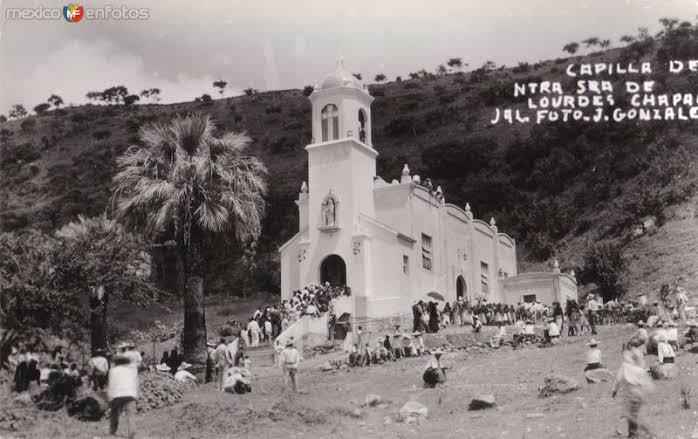
Photograph of the first years of the Lourdes Chapel. Photo: J. González.
Now it is the turn for the second generation of neighbors, the heirs of the luxurious country houses in Colonia Francesa and the inhabitants of the renowned neighborhood of Lourdes in Chapala, named in honor of their patron saint. These neighbors continue the restoration of the shrine week after week by selling churros, fritters, and sweets outside after mass, and others by making extravagant anonymous donations.
The fundraising work continues to help fund the remaining restoration work, and the next fair is already planned to be held on November 28 outside of the Parish of San Francisco de Asis. Another fair is planned for December 5 outside of the Chapel of Lourdes.
Translated by Kerry Watson.
The religious novena honoring St. Andrew the Apostle to be held in traditional manner
The banner listing the program of activities and participating guilds is on the façade of the church of St. Andrew the Apostle.
Sofía Medeles (Ajijic, Jal.)- The novena of nine days of religious celebrations to honor St. Andrew the Apostle will be carried out at the church in the customary way -unlike the celebrations in the main plaza, which will be modified- with the traditional mañanitas, masses, rosaries, and adoration of the Holy Eucharist.
The mañanitas will be held at 7:00 a.m.; while mass will be held at three different times, 8:00 a.m., 12:00 p.m. and 7:00 p.m. Rosaries will be at 6:30 p.m., and adoration of the Holy Eucharist- in the hands of adorers and honorary adorers – will be on Wednesday, November 24, Thursday, November 25 and Friday, November 26.
Translated by Kerry Watson.
New administration working hard to beautify Ajijic’s boardwalk
Officials painting the fencing along the boardwalk. Photo: Santiago Baeza
Sofía Medeles (Ajijic, Jal.)- Officials of the current PAN administration of Chapala, gave a facelift to the Ajijic boardwalk, painting area blue which previously were orange.
«We haven’t been able to address it as much as we would like, but we’ve already started. We are going to continue throughout the park and the boardwalk, renewing the paint of the dining areas and library, and at the beginning of the year we will start to renovate the aging grills» said Ajijic Delegado or town administrator Maximiliano «Max» Macias Arceo, who promised that the boardwalk and the beaches of Ajijic will continue to be beautified.
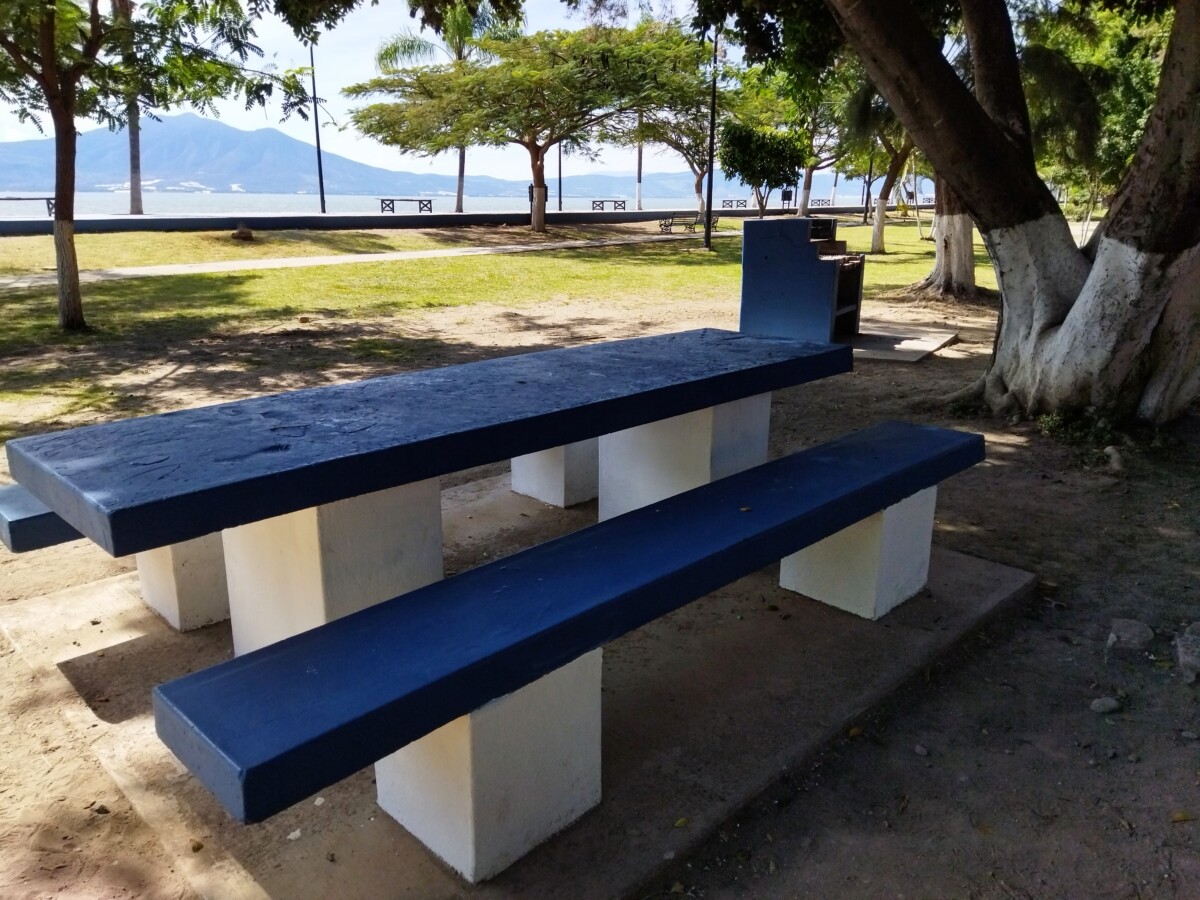
Painted and clean, this is how the dining areas and grills look. Photo: Sofía Medeles.
The Delegado said that a search has already begun for a new water pump to irrigate the green areas. He emphasized that the line will not be connected to the Municipal Potable Water and Sewage System (SIMAPA), but will take water from the lake, to improve the distribution of water to the neighbors of the boardwalk.
The green benches without back supports that were removed from the Ajijic plaza due to popular complaint will also be repaired and then relocated back to the boardwalk.
«We are looking to designate one day a week to clean up the boardwalk, remove the “lirio” or floating seaweed, and provide maintenance. We still don’t know if there will be new projects for these areas, but for the time being, they will be maintained and cleaned,» concluded the interviewee.
Translated by Kerry Watson
At least two women are attacked every day in Jocotepec
Jocotepec municipality has a population of 47,534 of which 24,129 are women, according to information from the Institute of Statistical and Geographic Information of Jalisco (IIEG), Jocotepec reports 870 attacks against women throughout the municipality so far, equivalent to 72.5 women attacked per month or 2.4 women per day. Photo Caption:The photograph is for illustrative purposes only.Photo:Héctor Ruiz Mejía.
Héctor Ruiz Mejía: According to data obtained by Laguna through a transparency request, 2.4 women are attacked everyday somewhere in the municipality of Jocotepec. San Juan Cosalá is Jocotepec’s most dangerous town for women for the third straight year.
San Juan Cosalá continues to be the most violent town despite a slight drop in reported attacks on women from their high point in 2019 . In that year authorities registered 224 attacks , which represented 18.6 women raped per month. The year 2020 saw a drop to 210 attacks (17.5 women per month) . In 2021 there have been a total of 126 reported cases (10.6 women per month) to date, but Cassandra Reyes, director of the Directorate of Substantive Equality, warns that December, traditionally the month with the highest incidence of violence, is still ahead.
«Something strange happens after Christmas and days of partying and alcohol before the New Year, the numbers of women victims of violence shoot up,» she said.
The numbers from the towns at the west end of Lake Chapala (known as the headwaters) are not encouraging either. Since 2020 attacks on women have increased almost double over 2019 as the municipal headwaters area recorded 109 cases in 2019 (9.08 women per month), 204 cases in 2020 (17 cases per month) and so far this year, 115 cases of violence have been reported (9.5 per month), with an anticipated increase in December.
However, last year saw the highest number of attacks, with 972 cases at the municipal level, which represented 81 women assaulted per month, largely influenced by the confinement caused by the pandemic, explained Casandra Reyes.
«The confinement represented a challenge for the women who were raped, as this made them live full time with their attacker who, being unemployed, increased their alcohol consumption», explained Cassandra.
Ajijic residents generally like the new pedestrian walkway on Colón
The walkway on Colón Street starts at the corner of Parroquia Street and ends at the Malecón. Photo: Sofía Medeles.
Sofía Medeles (Ajijic, Jal.)- The walkway at Colón and Morelos streets, in the downtown area of Ajijic, was received with good comments by Ajijitecos, and will be set up on weekends and holidays, authorities told Laguna.
The space set aside for pedestrians is only on the east side of the road, where cones have been placed to indicate that there is no parking on that side, thus allowing tourists and locals to walk easily in the pathway created by the cones.
The person in charge of Ajijic’s office, Maximiliano «Max» Macías, explained that, both a survey in social networks and in person revealed a positive response to the project, with a small percentage of negative opinion.
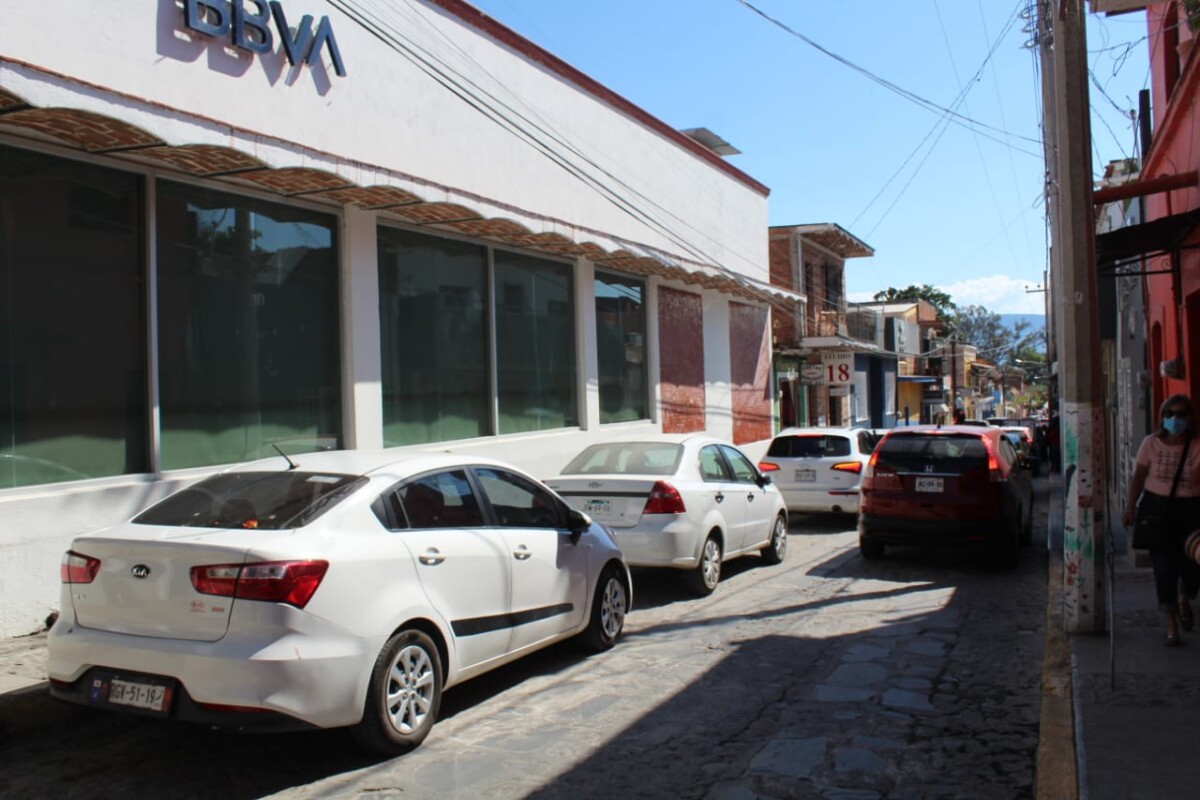
«I think it’s good, because this way the sidewalks are not so crowded, and there are no problems when passing people. And, since there are no people walking down the street, the flow of cars in that area is faster; it’s a very good idea». Photo: Sofía Medeles.
«For example, an American commented that since there is nowhere to park, there are visitors who park at his door inconveniencing him. We are taking into account all opinions and not trying not to mpact anyone just to attract more tourism», said Max.
Ajijitecos interviewed by Laguna, confirmed what he said. Aurora, a young neighbor of Ajijic said, «I think it’s good, because this way the sidewalks are not so crowded, and there are no problems when passing people. And, since there are no people walking down the street, the flow of cars in that area is faster; it’s a very good idea».
However, there was no lack of opposition comments which focused on the lack of parking on the main road.
«This project is very unfortunate, because they removed parking spaces without offering an alternative solution. It is a good idea that they encourage people to walk, but what if someone with a disability wants to go to the Malecon? they would have to park far away, and there is nothing to do if they are late and need to be closer. Let’s hope they solve the problem soon,» shared a resident of Ajijic.
Finally, Max added that together with the municipal president, Alejandro Aguirre Curiel, they are looking for another parking lot, although it may be difficult, since everything is very crowded. One solution could be to ask the merchants to leave the parking lots on the boardwalk free, he said. Finally, he asked the community of Ajijic to use the vehicle less, and try to move more on foot.
Translated by Patrick O’Heffernan
© 2016. Todos los derechos reservados. Semanario de la Ribera de Chapala
